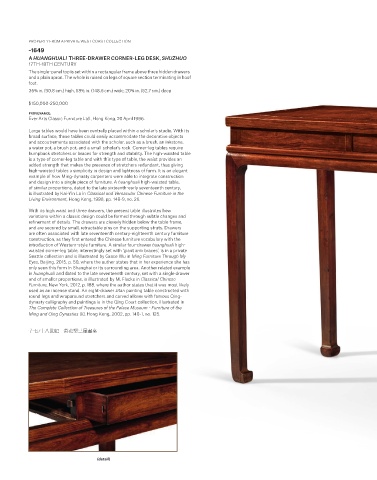Page 210 - Christies IMportant Chinese Art Sept 26 2020 NYC
P. 210
PROPERTY FROM A PRIVATE WEST COAST COLLECTION
~1649
A HUANGHUALI THREE-DRAWER CORNER-LEG DESK, SHUZHUO
17TH-18TH CENTURY
The single-panel top is set within a rectangular frame above three hidden drawers
and a plain apron. The whole is raised on legs of square section terminating in hoof
feet.
35æ in. (90.8 cm.) high, 58Ω in. (148.6 cm.) wide, 20æ in. (52.7 cm.) deep
$150,000-250,000
PROVENANCE:
Ever Arts Classic Furniture Ltd., Hong Kong, 20 April 1996.
Large tables would have been centrally placed within a scholar’s studio. With its
broad surface, these tables could easily accommodate the decorative objects
and accoutrements associated with the scholar, such as a brush, an inkstone,
a water pot, a brush pot, and a small scholar’s rock. Corner-leg tables require
humpback stretchers or braces for strength and stability. The high-waisted table
is a type of corner-leg table and with this type of table, the waist provides an
added strength that makes the presence of stretchers redundant, thus giving
high-waisted tables a simplicity in design and lightness of form. It is an elegant
example of how Ming-dynasty carpenters were able to integrate construction
and design into a single piece of furniture. A huanghuali high-waisted table,
of similar proportions, dated to the late sixteenth-early seventeenth century,
is illustrated by Kai-Yin Lo in Classical and Vernacular Chinese Furniture in the
Living Environment, Hong Kong, 1998, pp. 148-9, no. 26.
With its high waist and three drawers, the present table illustrates how
variations within a classic design could be formed through subtle changes and
refinement of details. The drawers are cleverly hidden below the table frame,
and are secured by small, retractable pins on the supporting struts. Drawers
are often associated with late seventeenth century-eighteenth century furniture
construction, as they first entered the Chinese furniture vocabulary with the
introduction of Western-style furniture. A similar four-drawer huanghuali high-
waisted corner-leg table, interestingly set with ‘giant arm braces’, is in a private
Seattle collection and is illustrated by Grace Wu in Ming Furniture Through My
Eyes, Beijing, 2015, p. 50, where the author states that in her experience she has
only seen this form in Shanghai or its surrounding area. Another related example
in huanghuali and dated to the late seventeenth century, set with a single drawer
and of smaller proportions, is illustrated by M. Flacks in Classical Chinese
Furniture, New York, 2012, p. 188, where the author states that it was most likely
used as an incense stand. An eight-drawer zitan painting table constructed with
round legs and wraparound stretchers and carved allover with famous Qing-
dynasty calligraphy and paintings is in the Qing Court collection, illustrated in
The Complete Collection of Treasures of the Palace Museum - Furniture of the
Ming and Qing Dynasties (II), Hong Kong, 2002, pp. 140-1, no. 125.
十七/十八世紀 黃花梨三屜書桌
(detail)

